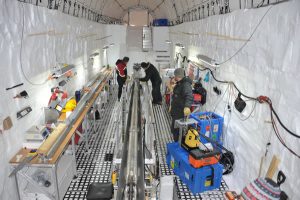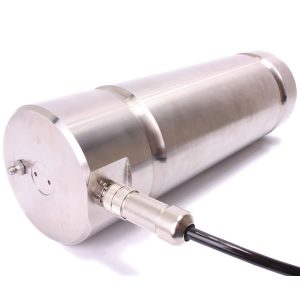We know we can provide sensors and instruments to work in freezing temperatures. Now let us prove it to you. The successful drilling of a 763m deep ice core from Antarctica using Applied Measurement sensors demonstrates beyond doubt the reliability of our products in sub-zero temperatures.
Project Aim: To Extract a 750m Deep Ice Core From Roosevelt Island in the Antarctic

Using Applied Measurements’ two customised DBEP shear pin load cells, a WS12 draw wire sensor and four intuitive2 displays, the RICE team were able to successfully extract a 763m deep ice core from an ice cap on Roosevelt Island over the austral summer of 2011/2012 and 2012/2013.[2] This core will provide an ice record for the last 20,000 years, determining the stability of the Ross Ice Shelf (the ma
in drainage route of the West Antarctica Ice Sheet).
“The most critical element of the control system is the load transducer pin, it performed flawlessly”
 Customised DBEP Series of Shear Pin Load Cells
Customised DBEP Series of Shear Pin Load Cells
The 2 customised DBEP load transducer pins designed and supplied by Applied Measurements, were able to compensate for the extreme Antarctic conditions by using a high stability temperature compensated strain gauge bridge to minimise the effects of temperature. This enabled them to operate accurately in temperatures as low as -30˚C. The customisation of the DBEP shear pin load cells enabled them to perform brilliantly within the extreme Antarctic environment. As Field and Operations Engineer Darcy Mandeno confirms, “The most critical element of the control system is the load transducer pin, it performed flawlessly, with the 1kg resolution we are able to “feel” what is happening in the ice with the drill, this feedback is an important element for the drillers confidence in what is happening down the hole.”[3]
To monitor the drilling forces the load pins used a built-in miniature ICA4S amplifier giving an output of 4-20mA. The ICA series of miniature amplifiers were ideal in this application as they can operate in temperatures as low as -40˚C. Their miniature design allowed them to fit inside the load pins where other larger amplifiers cannot.
 Heavy Duty WS12 Draw Wire Sensors
Heavy Duty WS12 Draw Wire Sensors
To monitor the extension movement of the drill mast we supplied the team with a WS12 draw wire sensor. The WS12 draw wire sensor is designed for harsh environments and heavy duty industrial applications as standard, due to its IP67 aluminium and stainless steel housing and its ability to operate at temperatures as low as -20˚C. Its ability to operate in tough conditions proved invaluable for the RICE team providing “very accurate and repeatable control with the mast position being known to within 1-2 mm.” Darcy Mandeno.[3]
Intuitive2 Indicators
Applied Measurements’ adaptable INT2-P indicators used with the 2 DBEP load pins and WS12 draw wire sensor and the INT2-C indicator used with the rotary encoder (supplied by another) were used to give the same RS485 output. The intuitive2 indicators are simple to install and calibrate and their modular construction meant the RICE team could take less spare parts to the remote location as many of the parts are inter-changeable.
The successful drilling of the ice core demonstrates the reliability of our products in sub-zero temperatures. “The displays and instruments worked well in what was quite arduous conditions” Darcy Mandeno.[3] We are proud to have been a part of this exciting and important global project. If you have a challenging project you wish to discuss, please contact our technical and knowledgeable sales team on +44 (0) 118 981 7339 or email [email protected]
References:
1 Victoria.ac.uk, (2014). RICE – Antarctic Research Centre – Victoria University of Wellington. [online] Available at http://www.victoria.ac.nz/antarctic/research/research-prog/rice [Accessed 27 Nov. 2014].
2 Victoria University of Wellington. Bedrock breakthrough in Antarctic [Press Release]. Retrieved from
http://antarcticanz.govt.nz/images/downloads/mediarelease/pr_121221_bedrock_breakthrough_in_antarctica.pdf
3 Darcy Mandeno, Field and Operations Engineer, Antarctic Research Centre, Victoria University of Wellington (personal communication, November 09, 2014)


 Customised
Customised  Heavy Duty
Heavy Duty 

